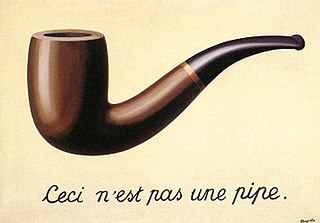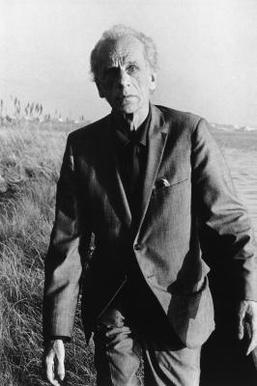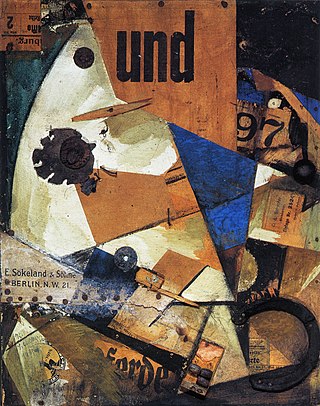Related Research Articles

Nanook of the North is a 1922 American silent film that combines elements of documentary and docudrama/docufiction, at a time when the concept of separating films into documentary and drama did not yet exist. In the tradition of what would later be called salvage ethnography, the film follows the struggles of the Inuk man named Nanook and his family in the Canadian Arctic. It is written and directed by Robert J. Flaherty, who also served as cinematographer, editor, and producer.

Surrealism is an art and cultural movement that developed in Europe in the aftermath of World War I in which artists aimed to allow the unconscious mind to express itself, often resulting in the depiction of illogical or dreamlike scenes and ideas. Its intention was, according to leader André Breton, to "resolve the previously contradictory conditions of dream and reality into an absolute reality, a super-reality", or surreality. It produced works of painting, writing, theatre, filmmaking, photography, and other media as well.
Surrealism in art, poetry, and literature uses numerous techniques and games to provide inspiration. Many of these are said to free imagination by producing a creative process free of conscious control. The importance of the unconscious as a source of inspiration is central to the nature of surrealism.

Trance and Dance in Bali is a short documentary film shot by the anthropologists Margaret Mead and Gregory Bateson during their research on Bali in the 1930s. It shows female dancers with sharp kris daggers dancing in trance, eventually stabbing themselves without injury. The film was not released until 1951. It has attracted praise from later anthropologists for its pioneering achievement, and criticism for its focus on the performance, omitting relevant details such as the conversation of the dancers.

Joseph Cornell was an American visual artist and film-maker, one of the pioneers and most celebrated exponents of assemblage. Influenced by the Surrealists, he was also an avant-garde experimental filmmaker. He was largely self-taught in his artistic efforts, and improvised his own original style incorporating cast-off and discarded artifacts. He lived most of his life in relative physical isolation, caring for his mother and his disabled brother at home, but remained aware of and in contact with other contemporary artists.

Drawn-on-film animation, also known as direct animation or animation without camera, is an animation technique where footage is produced by creating the images directly on film stock, as opposed to any other form of animation where the images or objects are photographed frame by frame with an animation camera.
21-87 is a 1963 Canadian abstract montage-collage film created by Arthur Lipsett that lasts 9 minutes and 33 seconds. The short, produced by the National Film Board of Canada, is a collage of snippets from discarded footage found by Lipsett in the editing room of the National Film Board, combined with his own black and white 16 mm footage which he shot on the streets of Montreal and New York City, among other locations.

Arthur Lipsett was a Canadian filmmaker with the National Film Board of Canada. His short, avant-garde collage films, which he described as "neither underground nor conventional”, contain elements of narrative, documentary, experimental collage, and visual essay. His first film, Very Nice, Very Nice, was nominated for an Academy Award.

Minotaure was a Surrealist-oriented magazine founded by Albert Skira and E. Tériade in Paris and published between 1933 and 1939. Minotaure published on the plastic arts, poetry, and literature, avant garde, as well as articles on esoteric and unusual aspects of literary and art history. Also included were psychoanalytical studies and artistic aspects of anthropology and ethnography. It was a lavish and extravagant magazine by the standards of the 1930s, profusely illustrated with high quality reproductions of art, often in color.
Antonino Romanov del Renzio dei Rossi di Castellone e Venosa (Toni del Renzio) (15 April 1915 – 7 January 2007), an artist and writer of Italian and Russian parentage, was leader of the British Surrealist Group for a period.
Surrealist cinema is a modernist approach to film theory, criticism, and production, with origins in Paris in the 1920s. The Surrealist movement used shocking, irrational, or absurd imagery and Freudian dream symbolism to challenge the traditional function of art to represent reality. Related to Dada cinema, Surrealist cinema is characterized by juxtapositions, the rejection of dramatic psychology, and a frequent use of shocking imagery. Philippe Soupault and André Breton’s 1920 book collaboration Les Champs magnétiques is often considered to be the first Surrealist work, but it was only once Breton had completed his Surrealist Manifesto in 1924 that ‘Surrealism drafted itself an official birth certificate.’

Jacqueline Lamba was a French painter and surrealist artist. She was married to the surrealist André Breton.

Collage is a technique of art creation, primarily used in the visual arts, but in music too, by which art results from an assemblage of different forms, thus creating a new whole.
Le Surréalisme au service de la révolution was a periodical issued by the Surrealist Group in Paris between 1930 and 1933. It was the successor of La Révolution surréaliste and preceded the primarily surrealist publication Minotaure.
The Memories of Angels is a 2008 collage film by Luc Bourdon.
A Trip Down Memory Lane is a 1965 experimental collage film by Arthur Lipsett, created by editing together images and sound clips from over 50 years of newsreel footage.
Bontoc Eulogy is a 1995 docudrama directed by Marlon Fuentes and distributed by the Corporation for Public Broadcasting. It was produced, written, directed, edited by, and stars Marlon Fuentes in the main role of a screen narrator going through an excruciating internal conflict regarding his heritage and following his thoughts as he recounts his grandfather's journey to the St. Louis World's Fair. It is the fifth film produced by Marlon Fuentes, following Arm in 1994.
Take the 5:10 to Dreamland is a 1976 short experimental film by Bruce Conner, using the technique of found footage. It is composed out of found images from the 1940s–1950s from different sources such as educational hm and soundtrack. It is closely related to Valse Triste, another found footage short by Bruce Conner.
American artist Joseph Cornell (1903–1972) is justifiably best known for his boxes which constitute a singular contribution to the Surrealist canon and to the art of assemblage. However, he also pursued experimental film-making as an amateur beginning in the 1930s. Cornell was the principal pioneer of collage films in a purely artistic sense and, although the introduction of his films into the public forum was relatively late compared to when they were made, his work as a filmmaker has been widely influential.
A still image film, also called a picture movie, is a film that consists primarily or entirely of still images rather than consecutive still images in succession, forgoing the illusion of motion either for aesthetic or practical reasons. These films usually include a standard soundtrack, similar to what is found in typical sound films, complete with music, sound effects, dialogue or narration. They may also use various editing techniques found in traditional films, such as dissolves, zooms, and panning.
References
- ↑ Beaver, Frank Eugene (January 2006). "Collage film". Dictionary of Film Terms: The Aesthetic Companion to Film Art. Peter Lang Publishing. p. 46. ISBN 978-0-8204-7298-0.
- ↑ Rony, Fatimah Tobing. The Quick and the Dead: Surrealism and the Found Ethnographic Footage Films of Bontoc Eulogy and Mother Dao: The Turtlelike. Camera Obscura. January 2003, Vol. 18 Issue 52
- ↑ Olivia Laing (July 25, 2015). "Joseph Cornell: how the reclusive artist conquered the art world – from his mum's basement". the Guardian .
- ↑ "Crossing the Great Sagrada (1924)". BFI Screenonline.
- ↑ "CINEMATEK - Koninklijk Belgisch Filmarchief". www.cinematek.be.
- ↑ André Breton, Nadja (Paris: Gallimard, 1964), and Breton, “As in a Wood.” L'age du cinema (1951) as reprinted in The Shadow and Its Shadows, ed. Paul Hammond (London: The British Film Institute, 1991). As cited by Rony, Fatimah Tobing. The Quick and the Dead: Surrealism and the Found Ethnographic Footage Films of Bontoc Eulogy and Mother Dao: The Turtlelike. Camera Obscura. Jan2003, Vol. 18 Issue 52
- ↑ Wees, William. Recycled Images: The Art and Politics of Found Footage Films Anthology Film Archives, New York: 1993: P.14 ISBN 0-911689-19-2
- ↑ Wees, William C. (Fall 2007). "From Compilation to Collage: The Found-Footage Films of Arthur Lipsett" (PDF). Martin Walsh Memorial Lecture, 2007. Canadian Journal of Film Studies. Retrieved 25 February 2012.
- ↑ TFH Exclusive: A Clip from THE MOVIE ORGY. Trailers from Hell on YouTube.
- ↑ "The Source". The A.V. Club .
- ↑ Visionaries|2010 Tribeca Festival|Tribeca
- ↑ Hays, Matthew (October 8, 2008). "Montreal, mon amour". CBC News. Canadian Broadcasting Corporation . Retrieved 28 January 2010.
- ↑ "Liverpool film portrait takes Cannes film festival by storm". Liverpool Daily Post. Retrieved 21 May 2008.
- ↑ Bray, Catherine (9 May 2016). "Hot Docs Film Review: 'Fraud'". Variety. Michelle Sobrino. Retrieved 15 May 2016.
- ↑ STAND BY FOR TAPE BACK-UP - Torino Film Fest
- ↑ British Council Film: Stand By For Tape Back-Up
- ↑ VISIONARY FILM: Stand By For Tape Back-Up (2015) Ross Sutherland
- ↑ LA 92, directed by TJ Martin and Daniel Lindsay|Time Out
- ↑ "La película infinita | IFFR". iffr.com.
- 1 2 "Oddball Films: Cine-Collage - Remixing the Moving Image - Thur. Sep 25 - 8PM".
- 1 2 3 4 Earmarked for Collision: A Highly Biased Tour of Collage Animation - Routledge
- ↑ McCormack, Tom (October 3, 2011). "Eye Washes: ROBERT BREER, 1926–2011". The Brooklyn Rail.
- ↑ Know Your Indie Filmmaker: Winston Hacking|Cartoon Brew
- ↑ Binocular Briefs - Spotlight on Collage|Animation World Network
- ↑ SATURDAY SHORT: ERODIUM THUNK (2018)|366 Weird Movies